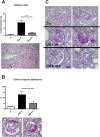Neonatal nephron loss during active nephrogenesis - detrimental impact with long-term renal consequences
- PMID: 29540722
- PMCID: PMC5852238
- DOI: 10.1038/s41598-018-22733-8
Neonatal nephron loss during active nephrogenesis - detrimental impact with long-term renal consequences
Abstract
Neonatal nephron loss may follow hypoxic-ischemic events or nephrotoxic medications. Its long-term effects on the kidney are still unclear. Unlike term infants, preterm neonates less than 36 weeks gestational age show ongoing nephrogenesis. We hypothesized that nephron loss during nephrogenesis leads to more severe renal sequelae than nephron loss shortly after the completion of nephrogenesis. Rats show nephrogenesis until day 10 of life resembling the situation of preterm infants. Animals were uninephrectomized at day 1 (UNX d1) resulting in nephron reduction during nephrogenesis and at day 14 of life (UNX d14) inducing nephron loss after the completion of nephrogenesis. 28 days after uninephrectomy the compensatory renal growth was higher in UNX d1 compared to UNX d14. Nephrin was reduced and collagen deposition increased in UNX d1. At 1 year of age, glomerulosclerosis and markers of tubulointerstitial damage were most prevalent in UNX d1. Moreover, the number of desmin-positive podocytes was higher and nephrin was reduced in UNX d1 indicating podocyte damage. Infiltration of inflammatory cells was heightened after UNX d1. Uninephrectomized animals showed no arterial hypertension. We conclude that neonatal nephron loss during active nephrogenesis leads to more severe glomerular and tubulointerstitial damage, which is not a consequence of compensatory arterial hypertension.
Conflict of interest statement
The authors declare no competing interests.
Figures







Similar articles
-
Sex differences in long-term kidney fibrosis following neonatal nephron loss during ongoing nephrogenesis.Mol Cell Pediatr. 2023 Aug 25;10(1):8. doi: 10.1186/s40348-023-00164-4. Mol Cell Pediatr. 2023. PMID: 37624430 Free PMC article.
-
Neonatal nephron loss during active nephrogenesis results in altered expression of renal developmental genes and markers of kidney injury.Physiol Genomics. 2021 Dec 1;53(12):509-517. doi: 10.1152/physiolgenomics.00059.2021. Epub 2021 Oct 27. Physiol Genomics. 2021. PMID: 34704838
-
Intrauterine growth restriction leads to a dysregulation of Wilms' tumour supressor gene 1 (WT1) and to early podocyte alterations.Nephrol Dial Transplant. 2013 Jun;28(6):1407-17. doi: 10.1093/ndt/gfs517. Epub 2012 Dec 9. Nephrol Dial Transplant. 2013. PMID: 23229934
-
Chronic intrauterine exposure to endotoxin does not alter fetal nephron number or glomerular size.Clin Exp Pharmacol Physiol. 2013 Nov;40(11):789-94. doi: 10.1111/1440-1681.12095. Clin Exp Pharmacol Physiol. 2013. PMID: 23586487 Review.
-
Pathways to nephron loss starting from glomerular diseases-insights from animal models.Kidney Int. 2005 Feb;67(2):404-19. doi: 10.1111/j.1523-1755.2005.67097.x. Kidney Int. 2005. PMID: 15673288 Review.
Cited by
-
Sex differences in long-term kidney fibrosis following neonatal nephron loss during ongoing nephrogenesis.Mol Cell Pediatr. 2023 Aug 25;10(1):8. doi: 10.1186/s40348-023-00164-4. Mol Cell Pediatr. 2023. PMID: 37624430 Free PMC article.
-
Neonatal acute kidney injury: a case-based approach.Pediatr Nephrol. 2021 Nov;36(11):3607-3619. doi: 10.1007/s00467-021-04977-1. Epub 2021 Feb 17. Pediatr Nephrol. 2021. PMID: 33594463 Review.
-
Structural and functional changes in the kidney caused by adverse fetal and neonatal environments.Mol Biol Rep. 2022 Mar;49(3):2335-2344. doi: 10.1007/s11033-021-06967-w. Epub 2021 Nov 24. Mol Biol Rep. 2022. PMID: 34817775 Review.
-
No benefit of HIF prolyl hydroxylase inhibition for hypertensive renal damage in renovascular hypertensive rats.Front Physiol. 2023 Jun 26;14:1208105. doi: 10.3389/fphys.2023.1208105. eCollection 2023. Front Physiol. 2023. PMID: 37435301 Free PMC article.
-
Low nephron endowment increases susceptibility to renal stress and chronic kidney disease.JCI Insight. 2023 Feb 8;8(3):e161316. doi: 10.1172/jci.insight.161316. JCI Insight. 2023. PMID: 36626229 Free PMC article.
References
Publication types
MeSH terms
Substances
LinkOut - more resources
Full Text Sources
Other Literature Sources
Medical

